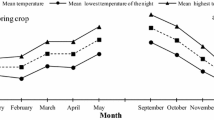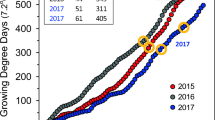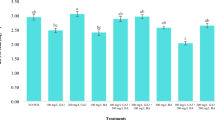Abstract
Katahdin potato plants were grown in a growth chamber undernoninducing conditions and treated with three anti-gibberellin growth retardants. Other plants were sprayed with gibberellic acid and placed in aninducing growth chamber adjusted to promote tuber induction. Treatments were repeated the following week. After final treatment, apical, sub-apical, medial and basal leaf-bud cuttings were taken from each plant and placed in a mist chamber. After two weeks, cuttings were examined for tuberization. Two of the retardants were associated with approximately 3 and 2 fold increases in tuberization over the non-induced control. Although induced control cuttings exhibited almost complete tuberization, application of gibberellic acid to plants grown under identical conditions, reduced tuberization 14 fold. Tuberization response of induced control cuttings was unaffected by stem location. In non-induced control and quaternary ammonium compound-treated cuttings, basal cuttings tuberized significantly better than those taken from higher on the stem. This pattern was eliminated for plants treated with the triazole compound. Below-ground portions of donor plants were also examined and showed a significant increase in average rhizome number and total rhizome length associated with inducing conditions. Tuber number of donor plants was also increased for those plants grown under inducing conditions or treated with the triazole compound under noninducing conditions.
Compendio
Se cultivaron plantas de papa Katahdin en una cámara de crecimiento bajo condiciones no inducidas y tratadas con tres giberilinas retardadoras del crecimiento. Otras plantas fueron asperjadas con ácido giberélico y colocadas en una cámara de crecimiento inducido regulada para promover la inducción de tubérculos. Los tratamientos se repitieron a la siguiente semana. Despueés del tratamiento final, se tomaron de cada planta esquejes de hoja-yema apicales, subapicales, medios y basales y se les colocó en una cámara nebulizadora. Después de dos semanas, se examinó la tuberización de los esquejes. Dos de los retardadores estuvieron asociados con incrementos en la tuberización que fueron aproximadamente el triple o el doble que los del control no inducio. No obstante que los esquejes del control inducido mostraron una tuberización casi completa, la aplicación de ácido giberélico a las plantas mantenidas bajo condiciones idénticas redujo la tuberización 14 veces. La respuesta en la tuberización de los esquejes del control inducido no fue afectada por la ubicación del tallo. En los esquejes del control no inducido y de aquellos tratados con compuesto de amonio cuaternario, los esquejes basales tuberizaron significativamente mejor que aquellos tornados a mayor altura del tallo. Esta situación quedó eliminada en las plantas tratadas con el compuesto triazole. Las partes, de las plantas madres, bajo el nivel del suelo fueron tamién examinadas y mostraron un incremento significativo, asociado con las condiciones de inducción, en el número promedio de rizomas y en la longitud total del rizoma. El número de tubérculos de las plantas madres también se incrementó para aquellas tratadas con el compuesto triazole bajo condiciones de no inducción.
Similar content being viewed by others
Literature Cited
Chapman, H.W. 1958. Tuberization in the potato plant. Physiol Plant 11:215–224.
Deuse, P. 1947. Tuberisation et auxine. Bull Soc R Bot Belg 79:79–84.
Dostal, R. 1945. On the question of organogens in plants. Bull Int Acad Tech Cl Sci Math Nat Med 46:1–20.
Essigmann-Capesius, I., A. Wilhelm and M. Bopp. 1981. Der Einfluss von Chlorolinchlorid (CCC) auf Zellwachstum und Ploidiegrad beiPhaseolus vulgaris. Z Pflanzenphysiol 104:353–362.
Ewing, E.E. 1985. Cuttings as simplified models of the potato plant, p. 153–207.In: PH. Li (Ed.). Potato Physiology. Academic Press, Orlando.
Ewing, E.E. and P.F. Wareing. 1978. Shoot, stolon, and tuber formation on potato (Solanum tuberosum L.) cuttings in response to photoperiods. Plant Physiol 61:348–353.
Forsline, P.L. and A.R. Langille. 1975. Endogenous cytokinins inSolanum tuberosum as influenced by photoperiod and temperature. Physiol Plant 34:75–77.
Forsline, P.L. and A.R. Langille. 1976. An assessment of the modifying effect of kinetin onin vitro tuberization of induced and non-induced tissues ofSolanum tuberosum. Can J Bot 54:2513–2516.
Gifford, R.M. and J. Moorby. 1967. The effect of CCC on the initiation of potato tubers. Eur Potato J 10:235–238.
Gregory, L.E. 1956. Some factors for tuberization in the potato. Amer J Bot 43:281–288.
Hammes, P.S. and P.C. Nel. 1975. Control mechanisms in the tuberization process. Potato Res 18:2562–2572.
Jones, R.L. and I.D.J. Phillips. 1966. Organs of gibberellin synthesis in light-grown sunflower plants. Plant Physiol 41:1381–1386.
Kahn, B.A. and E.E. Ewing. 1983. Factors controlling the basipetal pattern of tuberization in induced potato (Solanum tuberosum L.) cuttings. Ann Bot 52:861–874.
Koda, Y., E.A. Omer, T. Yoshihara, H. Shibata, S. Sakamura and Y. Okazawa. 1988. Isolation of a specific potato tuber-inducing substance from potato leaves. Plant Cell Physiol 29:1047–1051.
Kumar, D. and P.F. Wareing. 1974. Studies on tuberization ofSolanum andigena. New Phytol 73:833–840.
Kumar, P., A.P. Shamshery and A. Kumar. 1980. Effect of (2-chloroethyl) trimethylammonium chloride on plant growth, tuber initiation and yield of potato (Solanum tuberosum L.). Comp Physiol Ecol 5:107–109.
Langille, A.R. and P.L. Forsline. 1974. Influence of temperature and photoperiod on cytokinin pools in the potato,Solarium tuberosum L. Plant Sci Lett 2:189–191.
Lovell, P.H. and A. Booth. 1967. Effect of gibberellic acid on growth, tuber formation and carbohydrate distribution inSolanum tuberosum. New Phytol 66:525–537.
Madec, P. 1963. Tuber-forming substances in the potato, p. 121–131.In: J.D. Ivins and F.C. Milthorpe (Eds.) The Growth of the Potato. Butterworth, London.
Mauk, C.S. and A.R. Langille. 1978. Physiology of tuberization inSolanum tuberosum L. Cis-zeatin riboside in the potato plant: its identification and changes in endogenous levels as influenced by temperature and photoperiod. Plant Physiol 62:438–442.
Menzel, C.M. 1983. Tuberization in potato at high temperatures: gibberellin content and transport to buds. Ann Bot 52:697–702.
Okazawa, Y. 1959. Studies on the occurrence of natural gibberellin and its effects on the tuber formation of potato plants. Proc Crop Sci Soc Jpn 28:129–133.
Okazawa, Y. 1960. Studies on the relation between the tuber formation of potato plant and its natural gibberellin content. Proc Crop Sci Soc Jpn 29:121–124.
Pont-Lezica, R.F. 1970. Evolution des substances de type gibberellines chez la pomme de terre pendant la tuberisation, en relation avec longueur du jour et la temperature. Potato Res 13:323–331.
Rademacher, W., J. Jung, J.E. Graebe and L. Schwenen. 1984. On the mode of action of tetcyclacis and triazole growth retardants, p. 1–11.In: R. Menhenett and D.K. Lawrence (Eds.). Biochemical aspects of synthetic and naturally occurring plant growth regulators. Proc British Plant Growth Reg Group. London.
Railton, I.D. and P.F. Wareing. 1973. Effects of daylength on endogenous gibberellins in leaves ofSolanum andigena. I. Changes in levels of free acidic gibberellin-like substances. Physiol Plant 28:88–94.
Slater, J.W. 1968. The effect of night temperature on the initiation of the potato. Eur Potato J 11:14–32.
Smith, O.E. and C.E. Palmer. 1970. Cytokinin-induced tuber formation on stolons ofSolanum tuberosum. Physiol Plant 23:599–606.
Tizio, R. 1964. Action de l’acide gibberellique sur la tuberisation de la pomme de terre. Compt Rend Acad Sci 259:1187–1190.
Tizio, R. 1971. Action et role probable de certaines gibberellines (A1,A3,A4,A5,A7,A9, et A13) sur la croissance des stolons et la tuberisation de la pomme de terre (Solanum tuberosum L.). Potato Res 14:193–204.
Went, F.W. 1959. Effects of environment of parent and grandparent generations of tuber production of potatoes. Amer J Bot 46:277–282.
Author information
Authors and Affiliations
Rights and permissions
About this article
Cite this article
Langille, A.R., Hepler, P.R. Effect of three anti-gibberellin growth retardants on tuberization of induced and non-induced Katahdin potato leaf-bud cuttings. American Potato Journal 69, 131–142 (1992). https://doi.org/10.1007/BF02855342
Accepted:
Issue Date:
DOI: https://doi.org/10.1007/BF02855342




